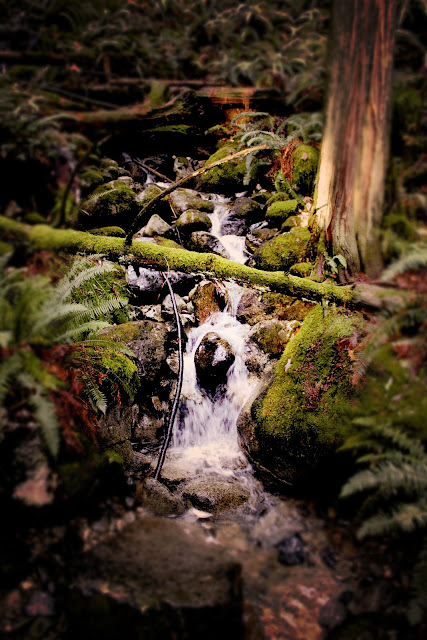In my work, nature is a jumping off point for setting. My observation of it, my reverence for it, shapes what I'm writing because it shapes my experience of life.
Touching base with nature, letting landscapes enter into me, and then using that new knowledge to re-imagine landscapes for my own made-up universe, that's an essential part of the writing process for me.
Everywhere I go, I search out natural wonders that might inspire and enrich my writing.
On a recent trip to British Columbia, I found fodder for a great fantasy world, for I discovered where the little people live...and the not so little people.
I can tell you, this Green Man took my breath away. Nature did this? Wow! I kept thinking there must be a sculptor hiding nearby. Of course, the sculptor was right in front of me all the time. As soon as I met this guy, I realized how far I could go working tree-lore into my story. Nothing I could make up would be more magical than this fellow in the woods.
This island is enchanted, of course. I'm sure it will fit it to my story. But if not this story, another.
And that is how I move through landscapes. I use the photographs to file away digitally and mentally my literary landscapes. They will surface again when needed, when space in a story opens up and invites them in.
On Vancouver Island I found the archetypal fairy tale bridge. Oh, I was so grateful. Mossy, and ancient—I imagine a zillion different scenes and characters emerging from this landscape.
Here is a very different landscape. I can't tell yet if it will be useful to this story I'm working on now. My young heroine and her friends are on quite a journey, but I'm not sure open ocean or sea coasts will be part of it. I offer the images anyway, to examine how dramatically different landscapes and settings affect mood in a story. That's not news, of course. But it's still good to remind myself to be judicious in adding imagined environments to a piece. I go back to Jean Rhys to learn judiciousness.
The islands of Indian Arm near Vancouver will be in a story one day, I hope. Mystical.
These seals are clearly otherworldly. They were in a harbour when I met them, waiting for fishermen to throw them scraps. I'm told it is their routine to show up just before dusk, as the fishermen clean their catches and toss fish heads and entrails (yummy!). My friends told me that when they lived on one of the smaller Gulf Islands, harbour seals like these joined them for a play in the water. I hope to be so lucky one day!
But the story that I'm consumed with now is one of forests—a huge part of the piece takes place in the gentle, mossy green forests inspired by both cedar groves in Ontario and the amazing rain forests of B.C.
A forest invites you to examine light and dark, bringing to mind the conflict of good and evil, an essential element in folk and fairy tales.
But without the dark, what would this picture be? This picture reminds me that one reveals the other. It is only with both light and dark that the forest's beauty emerges. That's something to think about.
Forest brooks and springs play a big part in the story. I am taking inspiration from archetypes like the Keeper of the Well.
Groves are key to the story, too. Secretive places with strong energy, they are.
The interdependence of life in a forest ecosystem infuses the story organically, but not necessarily overtly.
I explore how interaction with the forest ecosystem—the reverence we feel if we walk carefully there —can lead to a worshipful relationship with woodland, one that brings certain unexpected gifts to my heroine.
Mysteries are an essential part of the forest. The unknowable. The underground, hidden power of the tree is a great metaphor for the mystery of creation. The tree of life is a powerful motif. It's central to my own life, so it has to be central to this work.
But I'm also interested in the more menacing subalpine woods of the Rockies. The archtypal dark forest.
The first time I travelled to real mountains I was frightened and felt claustrophobic. Why claustrophobic when I was in the midst of what seemed an infinite wilderness?
I think it was the looming nature of mountains and the dark conifers that live there. They really close in upon you.
They evoke awe, where fear and wonder collide and make one feel very small indeed. I will draw on those memories/emotions to test my heroine. She just has to go to the mountains! Adversity abounds in such a setting!
These are some ways that I am piecing together a fantasy world for my characters. This world of ours is rich. I hope I do it justice in my work.





















No comments:
Post a Comment